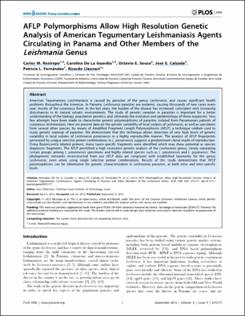| dc.contributor.author | Restrepo, Carlos M. | |
| dc.contributor.author | De La Guardia, Carolina | |
| dc.contributor.author | Sousa, Octavio E. | |
| dc.contributor.author | Fernández, Patricia L. | |
| dc.contributor.author | Calzada, José E. | |
| dc.contributor.author | Lleonart, Ricardo | |
| dc.date.accessioned | 2020-06-26T22:16:40Z | |
| dc.date.available | 2020-06-26T22:16:40Z | |
| dc.date.issued | 2013-09-09 | |
| dc.identifier.other | https://doi.org/10.1371/journal.pone.0073177 | |
| dc.identifier.uri | http://repositorio-indicasat.org.pa/handle/123456789/122 | |
| dc.description | American Tegumentary Leishmaniasis is caused by parasites of the genus Leishmania, and causes significant health problems throughout the Americas. In Panama, Leishmania parasites are endemic, causing thousands of new cases every year, mostly of the cutaneous form. In the last years, the burden of the disease has increased, coincident with increasing disturbances in its natural sylvatic environments. The study of genetic variation in parasites is important for a better understanding of the biology, population genetics, and ultimately the evolution and epidemiology of these organisms. Very few attempts have been made to characterize genetic polymorphisms of parasites isolated from Panamanian patients of cutaneous leishmaniasis. Here we present data on the genetic variability of local isolates of Leishmania, as well as specimens from several other species, by means of Amplified Fragment Length Polymorphisms (AFLP), a technique seldom used to study genetic makeup of parasites. We demonstrate that this technique allows detection of very high levels of genetic variability in local isolates of Leishmania panamensis in a highly reproducible manner. The analysis of AFLP fingerprints generated by unique selective primer combinations in L. panamensis suggests a predominant clonal mode of reproduction. Using fluorescently labeled primers, many taxon-specific fragments were identified which may show potential as species diagnostic fragments. The AFLP permitted a high resolution genetic analysis of the Leishmania genus, clearly separating certain groups among L. panamensis specimens and highly related species such as L. panamensis and L. guyanensis. The phylogenetic networks reconstructed from our AFLP data are congruent with established taxonomy for the genus Leishmania, even when using single selective primer combinations. Results of this study demonstrate that AFLP polymorphisms can be informative for genetic characterization in Leishmania parasites, at both intra and inter-specific levels. | en_US |
| dc.description.abstract | American Tegumentary Leishmaniasis is caused by parasites of the genus Leishmania, and causes significant health problems throughout the Americas. In Panama, Leishmania parasites are endemic, causing thousands of new cases every year, mostly of the cutaneous form. In the last years, the burden of the disease has increased, coincident with increasing disturbances in its natural sylvatic environments. The study of genetic variation in parasites is important for a better understanding of the biology, population genetics, and ultimately the evolution and epidemiology of these organisms. Very few attempts have been made to characterize genetic polymorphisms of parasites isolated from Panamanian patients of cutaneous leishmaniasis. Here we present data on the genetic variability of local isolates of Leishmania, as well as specimens from several other species, by means of Amplified Fragment Length Polymorphisms (AFLP), a technique seldom used to study genetic makeup of parasites. We demonstrate that this technique allows detection of very high levels of genetic variability in local isolates of Leishmania panamensis in a highly reproducible manner. The analysis of AFLP fingerprints generated by unique selective primer combinations in L. panamensis suggests a predominant clonal mode of reproduction. Using fluorescently labeled primers, many taxon-specific fragments were identified which may show potential as species diagnostic fragments. The AFLP permitted a high resolution genetic analysis of the Leishmania genus, clearly separating certain groups among L. panamensis specimens and highly related species such as L. panamensis and L. guyanensis. The phylogenetic networks reconstructed from our AFLP data are congruent with established taxonomy for the genus Leishmania, even when using single selective primer combinations. Results of this study demonstrate that AFLP polymorphisms can be informative for genetic characterization in Leishmania parasites, at both intra and inter-specific levels. | en_US |
| dc.language.iso | eng | en_US |
| dc.rights | info:eu-repo/semantics/openAccess | |
| dc.subject | AFLP | en_US |
| dc.subject | Polymorphisms Allow High Resolution Genetic | en_US |
| dc.subject | Leishmania Genus | en_US |
| dc.title | AFLP Polymorphisms Allow High Resolution Genetic Analysis of American Tegumentary Leishmaniasis Agents Circulating in Panama and Other Members of the Leishmania Genus | en_US |
| dc.type | info:eu-repo/semantics/article | en_US |
| dc.type | info:edu-repo/semantics/publishedVersion | |

